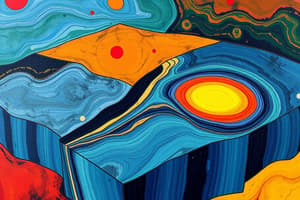Podcast
Questions and Answers
Which field of study focuses on the generation, propagation, and measurement of seismic waves through the Earth?
Which field of study focuses on the generation, propagation, and measurement of seismic waves through the Earth?
- Seismology (correct)
- Geology
- Plate Tectonics
- Geophysics
What does the word 'seismology' mean?
What does the word 'seismology' mean?
- Plate tectonics
- Geophysical processes
- Earthquake science (correct)
- Study of seismic waves
What is the main focus of seismology?
What is the main focus of seismology?
- Predicting earthquakes
- Studying the internal structure of the Earth (correct)
- Measuring seismic waves
- Understanding plate boundaries
What is one of the learning outcomes of this module?
What is one of the learning outcomes of this module?
What is the shape of the Earth?
What is the shape of the Earth?
Which field of study focuses on the generation, propagation, and measurement of seismic waves through the Earth?
Which field of study focuses on the generation, propagation, and measurement of seismic waves through the Earth?
What is the main focus of seismology?
What is the main focus of seismology?
What is the shape of the Earth?
What is the shape of the Earth?
What does the word 'seismology' mean?
What does the word 'seismology' mean?
What are some learning outcomes of this module?
What are some learning outcomes of this module?
Flashcards are hidden until you start studying
Study Notes
Module 1 CE 415c – EARTHQUAKE ENGINEERING: Chapter 1 - Seismology
- Seismology is the study of seismic waves and their generation, propagation, and measurement through the Earth.
- The word seismology comes from the Greek words "seismos" meaning earthquake and "logos" meaning science.
- Seismic wave propagation provides valuable information about the internal structure of the Earth.
- The learning outcomes of this module include identifying the Earth's internal structure, understanding plate boundaries and motion, and recognizing local plate boundaries.
- The Earth's shape is an oblate spheroid with a diameter of approximately 12,742 kilometers.
- The Earth's internal structure consists of the crust, mantle, outer core, and inner core.
- Plate boundaries are areas where tectonic plates interact, and their movement is responsible for earthquakes.
- There are three types of plate motions: convergent, divergent, and transform.
- Convergent plate boundaries occur when two plates collide, resulting in subduction zones or mountain ranges.
- Divergent plate boundaries occur when two plates move away from each other, creating rifts and mid-ocean ridges.
- Transform plate boundaries occur when two plates slide past each other horizontally, resulting in earthquakes.
- It is important to understand plate boundaries in the local area to assess the seismic hazard and potential for earthquakes.
Studying That Suits You
Use AI to generate personalized quizzes and flashcards to suit your learning preferences.



